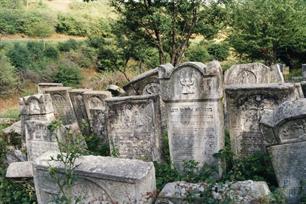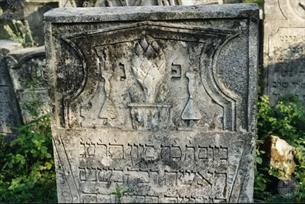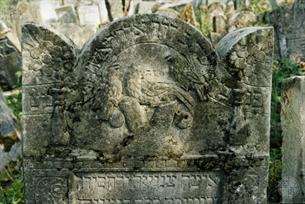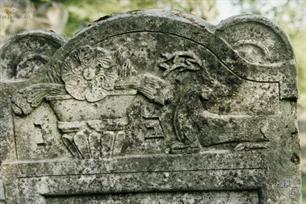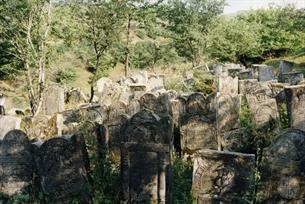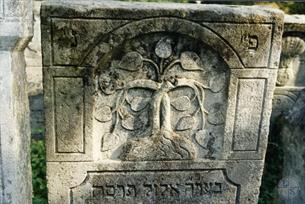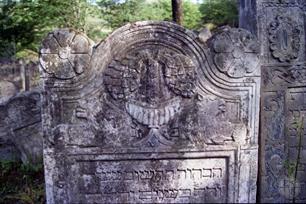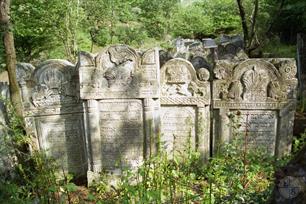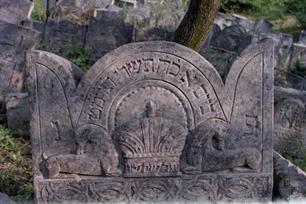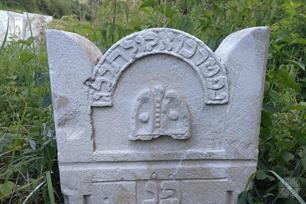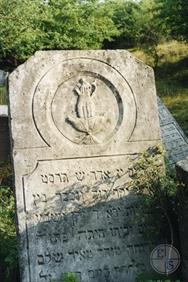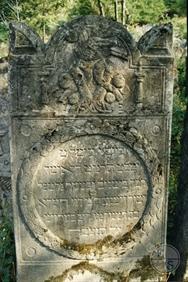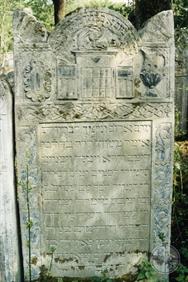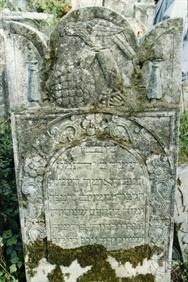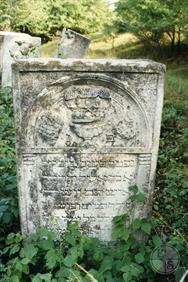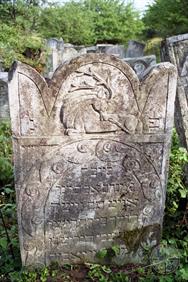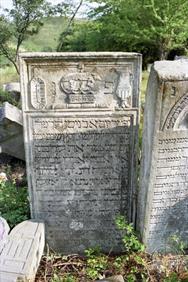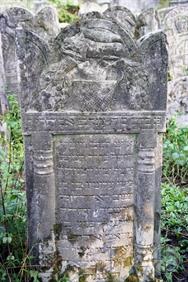Mykolayiv
Stryy district, Lviv region
Sources:
- Virtual Shtetl. Mykolaiv
Photo:
- Center for Jewish art. Jewish cemetery in Mykolaiv Dnistrovskyi
- Biblioteka Narodowa Polona. Mikołajow
- Virtual Shtetl. Mykolaiv
Photo:
- Center for Jewish art. Jewish cemetery in Mykolaiv Dnistrovskyi
- Biblioteka Narodowa Polona. Mikołajow
Mykolaiv (Ukrainian: Миколаїв, also referred to as Mykolayiv, Polish: Mikołajуw) is a city in Lviv region.
The earliest references the local Jews date back to the 16th century.
In 1595, Jerzy Mniszech, the provincial governor of Sandomierz, issued a regulation prohibiting Jews from settling and trading in Mikołajуw (Mykolaiv): “Considering that the presence of Jews causes more harm than good and greater impoverishment than enrichment, we decide that no Jew shall be allowed to build an abode or have a residence in the town and in the suburbs, and bring any goods.”
In 1596, the non-tolerance privilege was confirmed by Zygmunt III, and later by subsequent kings.
Jews reappeared in Mikołajуw at the beginning of the 17th century, but housing restrictions affected them until the 19th century. Nevertheless, the community continued to developed, as evidenced by its growth in size – in 1910 there were 632 Jews in the town, which constituted about 18% of all inhabitants.
In the following years, however, the number of Jews decreased by about 20%, which was caused by the outbreak of World War I and then by the Polish-Ukrainian conflict.
According to the census of 1931, 559 Jews lived in Mikołajуw, and in mid-1941 their number was estimated at over 600.
On 10 June 1942, 614 Jews were registered in the town.
The earliest references the local Jews date back to the 16th century.
In 1595, Jerzy Mniszech, the provincial governor of Sandomierz, issued a regulation prohibiting Jews from settling and trading in Mikołajуw (Mykolaiv): “Considering that the presence of Jews causes more harm than good and greater impoverishment than enrichment, we decide that no Jew shall be allowed to build an abode or have a residence in the town and in the suburbs, and bring any goods.”
In 1596, the non-tolerance privilege was confirmed by Zygmunt III, and later by subsequent kings.
Jews reappeared in Mikołajуw at the beginning of the 17th century, but housing restrictions affected them until the 19th century. Nevertheless, the community continued to developed, as evidenced by its growth in size – in 1910 there were 632 Jews in the town, which constituted about 18% of all inhabitants.
In the following years, however, the number of Jews decreased by about 20%, which was caused by the outbreak of World War I and then by the Polish-Ukrainian conflict.
According to the census of 1931, 559 Jews lived in Mikołajуw, and in mid-1941 their number was estimated at over 600.
On 10 June 1942, 614 Jews were registered in the town.
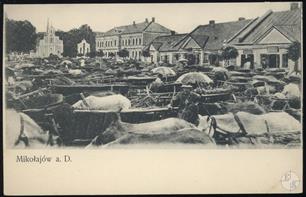 |
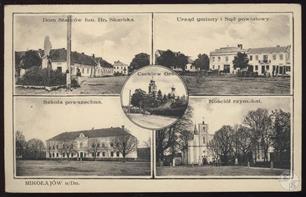 |
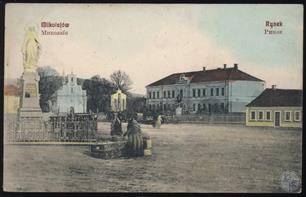 |
| Mykolayiv on Dnister, 1908 | Mykolayiv on Dnister, before 1939 | Mykolayiv, market, 1912 |
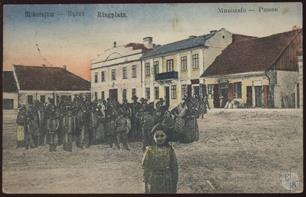 |
 |
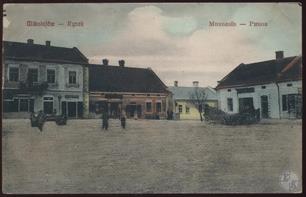 |
| Mykolayiv, market, 1916 | Mykolayiv, general view, 1907 | Mykolayiv, market, before 1910 |
On 2 July 1941, German troops entered Mikołajуw. In August 1941, the German civil administration was installed in the town; Mikołajуw became part of Stryj County of the District of Galicia. There was a German military police station in the town and a unit of the Ukrainian Auxiliary Police; these organisations were responsible for the persecution of Jews.
In the summer of 1941, the German occupation authorities ordered the creation of a Judenrat. Lawyer Salcberg became its chairman. A small Jewish police force was also formed. Jews were ordered to wear white armbands with a blue Star of David; all Jewish inhabitants of the town were registered and their property was confiscated. They also had to pay large contribution to Germans. They were obliged to perform forced labour, for example in quarries.
From August to September 1941, some Jewish men were sent to heavy labour in Carpathian forests. Only a few people managed to escape. Jewish craftsmen from Mikołajуw were exempted from forced labour because they worked directly for the Germans.
The so-called deportation Aktion was initiated at the beginning of September 1942. About 500 Jews were deported to the German Nazi extermination camp in Bełżec, and several dozen were murdered on the spot. On 7 October 1942, Germans issued an order that the remaining Jews be transferred to the Stryi ghetto by the end of the month. Only physicians and pharmacists, garbage collectors and Jews working for the Judenrat were allowed to remain in the town.
After the Aktion, a number of Jews able to work still remained in Mikołajуw. It was a group of ca. 100 people; 57 of them were employed in the Judenrat. The rest were probably doctors, dentists and pharmacists. The Jews lived in a fenced area, described in some sources as the remains of the ghetto. They were all shot in two “Aktions” – on 5 February and 12 June 1943.
It is estimated that about 200 Jews were killed in the town in the years 1942-1943.
In the summer of 1941, the German occupation authorities ordered the creation of a Judenrat. Lawyer Salcberg became its chairman. A small Jewish police force was also formed. Jews were ordered to wear white armbands with a blue Star of David; all Jewish inhabitants of the town were registered and their property was confiscated. They also had to pay large contribution to Germans. They were obliged to perform forced labour, for example in quarries.
From August to September 1941, some Jewish men were sent to heavy labour in Carpathian forests. Only a few people managed to escape. Jewish craftsmen from Mikołajуw were exempted from forced labour because they worked directly for the Germans.
The so-called deportation Aktion was initiated at the beginning of September 1942. About 500 Jews were deported to the German Nazi extermination camp in Bełżec, and several dozen were murdered on the spot. On 7 October 1942, Germans issued an order that the remaining Jews be transferred to the Stryi ghetto by the end of the month. Only physicians and pharmacists, garbage collectors and Jews working for the Judenrat were allowed to remain in the town.
After the Aktion, a number of Jews able to work still remained in Mikołajуw. It was a group of ca. 100 people; 57 of them were employed in the Judenrat. The rest were probably doctors, dentists and pharmacists. The Jews lived in a fenced area, described in some sources as the remains of the ghetto. They were all shot in two “Aktions” – on 5 February and 12 June 1943.
It is estimated that about 200 Jews were killed in the town in the years 1942-1943.

- Home
- Shtetls
- Vinnytsia region
- Volyn region
- Dnipro region
- Donetsk region
- Zhytomyr region
- Zakarpattia region
- Zaporizhzhia region
- Ivano-Frankivsk region
- Kyiv region
- Kropyvnytskyi region
- Luhansk region
- Lviv region
- Mykolayiv region
- Odessa region
- Poltava region
- Rivne region
- Sumy region
- Ternopil region
- Kharkiv region
- Kherson region
- Khmelnytskyi region
- Chernihiv region
- Chernivtsi region
- Cherkasy region
- Crimea
- Synagogues
- Cemeteries
- Objects & guides
- Old photos
- History
- Contact
Jewish towns of Ukraine
Jewish towns of Ukraine
My shtetl
My shtetl
Donate
